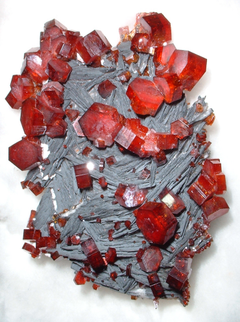Vanadinite
| Vanadinite | |
|---|---|

|
|
| General | |
| Category |
Vanadate mineral Apatite group |
|
Formula (repeating unit) |
Pb5(VO4)3Cl |
| Strunz classification | 8.BN.05 |
| Crystal system | Hexagonal |
| Crystal class | Dipyramidal (6/m) H-M symbol: (6/m) |
| Space group | P63/m |
| Unit cell | a = 10.3174, c = 7.3378 [Å]; Z = 2 |
| Identification | |
| Formula mass | 1416.27 g/mol |
| Colour | Bright red, orange-red, red-brown, brown, yellow, grey or colourless, may be concentrically zoned |
| Crystal habit | Prismatic or nodular; may be acicular, hairlike, fibrous; rarely rounded, globular |
| Cleavage | None |
| Fracture | Uneven to conchoidal |
| Tenacity | Brittle |
| Mohs scale hardness | 3–4 |
| Lustre | Resinous to sub-adamantine |
| Streak | brownish yellow |
| Diaphaneity | Transparent, translucent or opaque |
| Specific gravity | 6.8–7.1 (measured) 6.95 (calculated) |
| Optical properties | Uniaxial (-) |
| Refractive index | nω = 2.416, nε = 2.350 |
| Birefringence | δ = 0.066 |
| Ultraviolet fluorescence | None |
| Melting point | 3470° F or 1910°C |
| References | |
Vanadinite is a mineral belonging to the apatite group of phosphates, with the chemical formula Pb5(VO4)3Cl. It is one of the main industrial ores of the metal vanadium and a minor source of lead. A dense, brittle mineral, it is usually found in the form of red hexagonal crystals. It is an uncommon mineral, formed by the oxidation of lead ore deposits such as galena. First discovered in 1801 in Mexico, vanadinite deposits have since been unearthed in South America, Europe, Africa, and North America.
Vanadinite is an uncommon mineral, only occurring as the result of chemical alterations to a pre-existing material. It is therefore known as a secondary mineral. It is found in arid climates and forms by oxidation of primary lead minerals. Vanadinite is especially found in association with the lead sulfide, galena. Other associated minerals include wulfenite, limonite, and barite.
It was originally discovered in Mexico by the Spanish mineralogist Andrés Manuel del Río in 1801. He called the mineral "brown lead" and asserted that it contained a new element, which he first named pancromium and later, erythronium. However, he was later led to believe that this was not a new element but merely an impure form of chromium. In 1830, Nils Gabriel Sefström discovered a new element, which he named vanadium. It was later revealed that this was identical to the metal discovered earlier by Andrés Manuel del Río. Del Río's "brown lead" was also rediscovered, in 1838 in Zimapan, Hidalgo, Mexico, and was named vanadinite because of its high vanadium content. Other names that have since been given to vanadinite are johnstonite and lead vanadate.
...
Wikipedia
